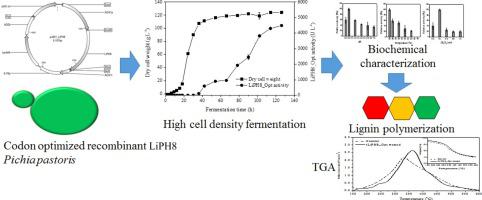当前位置:
X-MOL 学术
›
Enzyme Microb. Technol.
›
论文详情
Our official English website, www.x-mol.net, welcomes your
feedback! (Note: you will need to create a separate account there.)
Synergistic codon optimization and bioreactor cultivation towards enhanced secretion of fungal lignin peroxidase in Pichia pastoris: enzymatic valorization of technical (industrial) lignins
Enzyme and Microbial Technology ( IF 3.4 ) Pub Date : 2020-09-01 , DOI: 10.1016/j.enzmictec.2020.109593 B M Majeke 1 , M García-Aparicio 2 , O D Biko 3 , M Viljoen-Bloom 3 , W H van Zyl 3 , J F Görgens 1
Enzyme and Microbial Technology ( IF 3.4 ) Pub Date : 2020-09-01 , DOI: 10.1016/j.enzmictec.2020.109593 B M Majeke 1 , M García-Aparicio 2 , O D Biko 3 , M Viljoen-Bloom 3 , W H van Zyl 3 , J F Görgens 1
Affiliation

|
Lignin peroxidase (LiP) is a well-recognized enzyme for its ability to oxidize lignins, but its commercial availability is limited, which hinders the biotechnological application of LiP-based bioprocesses in lignocellulose biorefineries. This study evaluated a combination strategy to improve the expression of LiP to promote its practical use. The strategy included optimization of the lipH8 gene of Phanerochaete chrysosporium according to the codon usage of Pichia pastoris, followed by fed-batch fermentation using a 14 L bioreactor (10 L working volume). The combination strategy achieved a maximum volumetric LiPH8 activity of 4480 U L-1, protein concentration of 417 mg L-1 and a specific activity of 10.7 U mg-1, which was higher than previous reports. Biochemical characterization showed that the recombinant LiPH8 (rLiPH8) was optimum at pH 3.0, 25 ℃ and 0.4 mM H2O2. Using the optimized conditions, rLiPH8 was used to treat isolated technical lignins namely soda-anthraquinone (SAQ) lignin and steam explosion (S-E) lignin. High-performance gel permeation chromatography (HP-GPC) analysis showed that the molecular weight (Mw) of SAQ and S-E lignins were increased by 1.43-and 1.14-fold, respectively, after the enzymatic treatment. Thermogravimetric analysis (TGA) also showed that the thermal stability of the lignins was improved, indicating that the enzyme treatment of lignins with rLiPH8 resulted in lignin re-polymerization. As the first report on rLiPH8 production using P. pastoris, this study has shed light on the possible route for the enhancement of rLiPH8 production and its potential application for upgrading technical lignins.
中文翻译:

协同密码子优化和生物反应器培养以增强毕赤酵母中真菌木质素过氧化物酶的分泌:技术(工业)木质素的酶促价值
木质素过氧化物酶 (LiP) 是一种公认的酶,因为它具有氧化木质素的能力,但其商业可用性有限,这阻碍了基于 LiP 的生物工艺在木质纤维素生物精炼厂中的生物技术应用。本研究评估了改善 LiP 表达以促进其实际应用的组合策略。该策略包括根据毕赤酵母的密码子使用优化 Phanerochaete chrysosporium 的 lipH8 基因,然后使用 14 L 生物反应器(10 L 工作体积)进行分批补料发酵。该组合策略实现了 4480 U L-1 的最大体积 LiPH8 活性、417 mg L-1 的蛋白质浓度和 10.7 U mg-1 的比活性,高于之前的报道。生化表征表明,重组 LiPH8 (rLiPH8) 在 pH 3.0 时最佳,25 ℃和 0.4 mM H2O2。使用优化的条件,rLiPH8 用于处理分离的工业木质素,即苏打-蒽醌 (SAQ) 木质素和蒸汽爆炸 (SE) 木质素。高效凝胶渗透色谱 (HP-GPC) 分析表明,经过酶处理后,SAQ 和 SE 木质素的分子量 (Mw) 分别增加了 1.43 和 1.14 倍。热重分析 (TGA) 还表明木质素的热稳定性得到改善,表明用 rLiPH8 酶处理木质素导致木质素再聚合。作为第一份使用毕赤酵母生产 rLiPH8 的报告,本研究阐明了提高 rLiPH8 生产的可能途径及其在技术木质素升级方面的潜在应用。rLiPH8 用于处理分离的工业木质素,即苏打-蒽醌 (SAQ) 木质素和蒸汽爆炸 (SE) 木质素。高效凝胶渗透色谱 (HP-GPC) 分析表明,经过酶处理后,SAQ 和 SE 木质素的分子量 (Mw) 分别增加了 1.43 和 1.14 倍。热重分析 (TGA) 还表明木质素的热稳定性得到改善,表明用 rLiPH8 酶处理木质素导致木质素再聚合。作为第一份使用毕赤酵母生产 rLiPH8 的报告,本研究阐明了提高 rLiPH8 生产的可能途径及其在技术木质素升级方面的潜在应用。rLiPH8 用于处理分离的工业木质素,即苏打-蒽醌 (SAQ) 木质素和蒸汽爆炸 (SE) 木质素。高效凝胶渗透色谱 (HP-GPC) 分析表明,经过酶处理后,SAQ 和 SE 木质素的分子量 (Mw) 分别增加了 1.43 和 1.14 倍。热重分析 (TGA) 还表明木质素的热稳定性得到改善,表明用 rLiPH8 酶处理木质素导致木质素再聚合。作为第一份使用毕赤酵母生产 rLiPH8 的报告,本研究阐明了提高 rLiPH8 生产的可能途径及其在技术木质素升级方面的潜在应用。高效凝胶渗透色谱 (HP-GPC) 分析表明,经过酶处理后,SAQ 和 SE 木质素的分子量 (Mw) 分别增加了 1.43 和 1.14 倍。热重分析 (TGA) 还表明木质素的热稳定性得到改善,表明用 rLiPH8 酶处理木质素导致木质素再聚合。作为第一份使用毕赤酵母生产 rLiPH8 的报告,本研究阐明了提高 rLiPH8 生产的可能途径及其在技术木质素升级方面的潜在应用。高效凝胶渗透色谱 (HP-GPC) 分析表明,经过酶处理后,SAQ 和 SE 木质素的分子量 (Mw) 分别增加了 1.43 和 1.14 倍。热重分析 (TGA) 还表明木质素的热稳定性得到改善,表明用 rLiPH8 酶处理木质素导致木质素再聚合。作为第一份使用毕赤酵母生产 rLiPH8 的报告,本研究阐明了提高 rLiPH8 生产的可能途径及其在技术木质素升级方面的潜在应用。热重分析 (TGA) 还表明木质素的热稳定性得到改善,表明用 rLiPH8 酶处理木质素导致木质素再聚合。作为第一份使用毕赤酵母生产 rLiPH8 的报告,本研究阐明了提高 rLiPH8 生产的可能途径及其在技术木质素升级方面的潜在应用。热重分析 (TGA) 还表明木质素的热稳定性得到改善,表明用 rLiPH8 酶处理木质素导致木质素再聚合。作为第一份使用毕赤酵母生产 rLiPH8 的报告,本研究阐明了提高 rLiPH8 生产的可能途径及其在技术木质素升级方面的潜在应用。
更新日期:2020-09-01
中文翻译:

协同密码子优化和生物反应器培养以增强毕赤酵母中真菌木质素过氧化物酶的分泌:技术(工业)木质素的酶促价值
木质素过氧化物酶 (LiP) 是一种公认的酶,因为它具有氧化木质素的能力,但其商业可用性有限,这阻碍了基于 LiP 的生物工艺在木质纤维素生物精炼厂中的生物技术应用。本研究评估了改善 LiP 表达以促进其实际应用的组合策略。该策略包括根据毕赤酵母的密码子使用优化 Phanerochaete chrysosporium 的 lipH8 基因,然后使用 14 L 生物反应器(10 L 工作体积)进行分批补料发酵。该组合策略实现了 4480 U L-1 的最大体积 LiPH8 活性、417 mg L-1 的蛋白质浓度和 10.7 U mg-1 的比活性,高于之前的报道。生化表征表明,重组 LiPH8 (rLiPH8) 在 pH 3.0 时最佳,25 ℃和 0.4 mM H2O2。使用优化的条件,rLiPH8 用于处理分离的工业木质素,即苏打-蒽醌 (SAQ) 木质素和蒸汽爆炸 (SE) 木质素。高效凝胶渗透色谱 (HP-GPC) 分析表明,经过酶处理后,SAQ 和 SE 木质素的分子量 (Mw) 分别增加了 1.43 和 1.14 倍。热重分析 (TGA) 还表明木质素的热稳定性得到改善,表明用 rLiPH8 酶处理木质素导致木质素再聚合。作为第一份使用毕赤酵母生产 rLiPH8 的报告,本研究阐明了提高 rLiPH8 生产的可能途径及其在技术木质素升级方面的潜在应用。rLiPH8 用于处理分离的工业木质素,即苏打-蒽醌 (SAQ) 木质素和蒸汽爆炸 (SE) 木质素。高效凝胶渗透色谱 (HP-GPC) 分析表明,经过酶处理后,SAQ 和 SE 木质素的分子量 (Mw) 分别增加了 1.43 和 1.14 倍。热重分析 (TGA) 还表明木质素的热稳定性得到改善,表明用 rLiPH8 酶处理木质素导致木质素再聚合。作为第一份使用毕赤酵母生产 rLiPH8 的报告,本研究阐明了提高 rLiPH8 生产的可能途径及其在技术木质素升级方面的潜在应用。rLiPH8 用于处理分离的工业木质素,即苏打-蒽醌 (SAQ) 木质素和蒸汽爆炸 (SE) 木质素。高效凝胶渗透色谱 (HP-GPC) 分析表明,经过酶处理后,SAQ 和 SE 木质素的分子量 (Mw) 分别增加了 1.43 和 1.14 倍。热重分析 (TGA) 还表明木质素的热稳定性得到改善,表明用 rLiPH8 酶处理木质素导致木质素再聚合。作为第一份使用毕赤酵母生产 rLiPH8 的报告,本研究阐明了提高 rLiPH8 生产的可能途径及其在技术木质素升级方面的潜在应用。高效凝胶渗透色谱 (HP-GPC) 分析表明,经过酶处理后,SAQ 和 SE 木质素的分子量 (Mw) 分别增加了 1.43 和 1.14 倍。热重分析 (TGA) 还表明木质素的热稳定性得到改善,表明用 rLiPH8 酶处理木质素导致木质素再聚合。作为第一份使用毕赤酵母生产 rLiPH8 的报告,本研究阐明了提高 rLiPH8 生产的可能途径及其在技术木质素升级方面的潜在应用。高效凝胶渗透色谱 (HP-GPC) 分析表明,经过酶处理后,SAQ 和 SE 木质素的分子量 (Mw) 分别增加了 1.43 和 1.14 倍。热重分析 (TGA) 还表明木质素的热稳定性得到改善,表明用 rLiPH8 酶处理木质素导致木质素再聚合。作为第一份使用毕赤酵母生产 rLiPH8 的报告,本研究阐明了提高 rLiPH8 生产的可能途径及其在技术木质素升级方面的潜在应用。热重分析 (TGA) 还表明木质素的热稳定性得到改善,表明用 rLiPH8 酶处理木质素导致木质素再聚合。作为第一份使用毕赤酵母生产 rLiPH8 的报告,本研究阐明了提高 rLiPH8 生产的可能途径及其在技术木质素升级方面的潜在应用。热重分析 (TGA) 还表明木质素的热稳定性得到改善,表明用 rLiPH8 酶处理木质素导致木质素再聚合。作为第一份使用毕赤酵母生产 rLiPH8 的报告,本研究阐明了提高 rLiPH8 生产的可能途径及其在技术木质素升级方面的潜在应用。











































 京公网安备 11010802027423号
京公网安备 11010802027423号